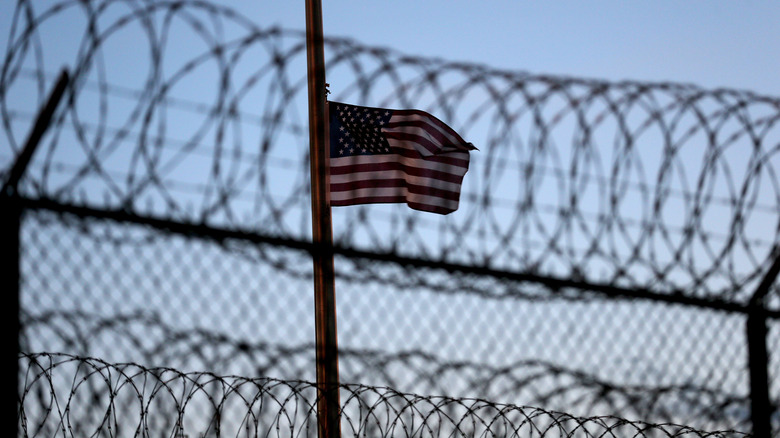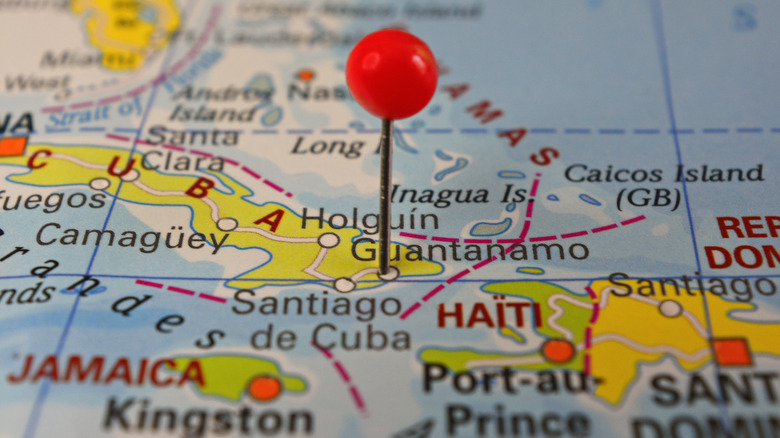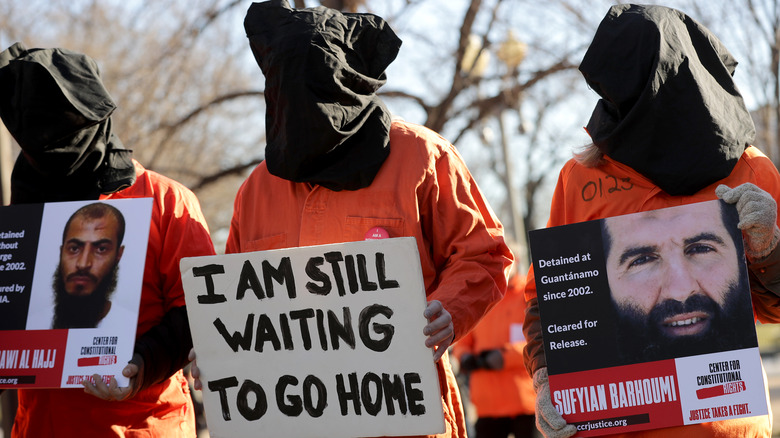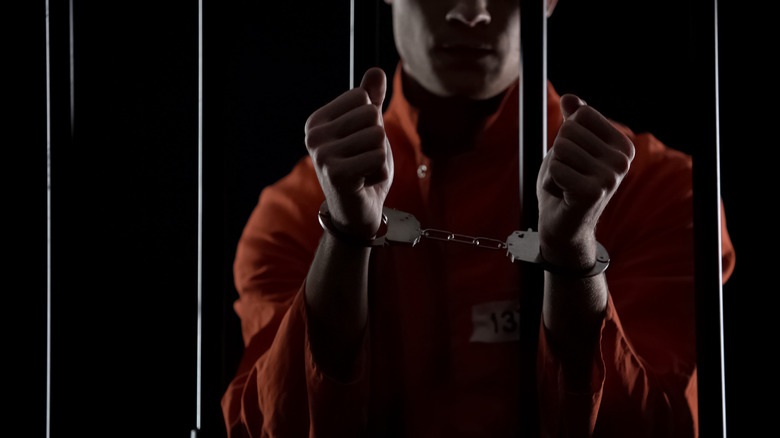The Navy Runs The Most Bizarre Gift Shop In Guantánamo Bay
"Step right up, step right up! Are you interested in governmental black sites where prisoners are kept in indefinite detention with no opportunity for legal recourse? Are you a fan of some of the United States' more notable, uh ... 'enhanced interrogation' methods? Well then, by golly you too can take home your very own, one-of-a-kind, name-brand, logo-emblazoned memorabilia from Gitmo. That's right — Gitmo — the place where enemies of state go!"
That little fictional promo, the reader might be surprised to find out, is far from inaccurate. If a U.S. citizen, or (not recommending this) some other tourist were to stroll into southeast Cuba, past all the beautiful beaches and gorgeous mountains flush with greenery, that person could stumble across the U.S. Navy's very own Guantánamo Bay gift shop. Who knows? Maybe local teens, the kind playing in a nearby park in a photo on Insider, could pass through the shop door and economically contribute to the dystopian horror by buying a "Straight Outta GTMO" coffee mug. Heck, they could even grab a t-shirt, Frisbee, beer koozie, and drop by McDonald's or Subway before heading back home and pretending to be in an American suburban summertime backyard.
Too harsh? You decide. While we're not quite sure if the minds behind the Guantánamo Bay gift shop were trying to be funny, make Gitmo's 6,000 personnel feel at home, or just make money, "in poor taste" definitely seems to apply.
Little info, lots of outrage
We have to be clear from the Git-go: any kind of pertinent, reasonable, fundamental questions like, "Who made this gift shop?" "Why was it made?" "When was it made?" "Do they sell take-home waterboarding kits?" and more, must be met with a giant shoulder shrug and the admission, "We have no earthly clue." It's Guantánamo Bay, right? It's supposed to be hush-hush — national security, the deflection of public outrage, and all that. Besides, you can just zoom in on Google Maps and scope the place out. Using terrain mode, you can even behold the texture of the military prison's stone walls.
We do, however, have some details about Gitmo's gift shop, largely thanks to journalist Sarah Mirk, author of 2020's illustrated oral history "Guantanamo Voices: True Accounts from the World's Most Infamous Prison" (via her website, Mirkwork). Back in 2019 she snapped some definitely not-allowed photos while on a visit to Gitmo, as Insider shows. As recently as August 15, 2022, New York Times journalist Carol Rosenberg stated on Twitter that reporters were not allowed to take photos inside the gift shop. So, during a recent detention center visit Rosenberg took a picture of a "mindfulness" mug from a nearby Cuban gift shop, instead.
At minimum, we know that the Gitmo gift shop resides about 4.5 miles away from Guantánamo's military prison, is operated by the U.S. Navy Exchange, and sells tourist-centric items like hoodies, hats, plushies, and more. It's basically a transplanted slice of Americana.
Gitmo's long, troubled history
It pays to talk about Guantánamo Bay's history to try and understand why anyone would think it's okay to open a kitschy gift shop there portraying America's premiere torture facility like Disneyworld. After all, Gitmo is still open despite all promises to close it across multiple presidential administrations. It still houses, to this day, 36 individuals out of about 780 total detainees, many of whom have lived there since 2002, as an astonishingly detailed special report by The New York Times depicts.
The troubled history of Guantánamo Bay goes back way further than many may realize, and helps to explain the long-held enmity between the United States and Cuba. Back in 1898 the U.S. occupied Cuba following the Spanish-American war, and four years later in 1902 backed out and granted the nation sovereignty, as Florida International University's Cuban Research Institute describes. Naturally, the U.S. installed an American citizen as Cuba's first president, Tomás Estrada Palma. A year later, the U.S. signed a treaty enacting the Platt Amendment, which leased Guantánamo Bay and Bahía Honda as naval bases.
Thus began a non-stop series of back-and-forth Cuban insurrections, U.S. "military interventions," mediations, and overturned governmental regimes, all the way to 2002. That year, as Vox explains, following the 9/11 attacks on the World Trade Center, Guantánamo Bay opened its military prison. Detainees didn't have to be charged with a crime, and could be held as long as the powers that be said so.
Three administrations and still open
Guantánamo Bay's prison came to infamy during the George W. Bush administration not only for having been intentionally opened "outside of U.S. and international law" (via Vox), but because of confirmed torture methods conducted on-site — "enhanced interrogation," as the euphemism went. These methods, employed against the supposed "worst of the worst" of alleged terrorists (via The Washington Post), were described by detainee Majid Khan in 2021: "suspended naked from a ceiling beam for long periods, doused repeatedly with ice water to keep him awake for days ... having his head held under water to the point of near drowning, only to have water poured into his nose and mouth when the interrogators let him up ... beaten, given forced enemas, sexually assaulted and starved" (via The Guardian).
Countless exposés let the American public know what was going on, and when Barack Obama took office in 2009, he swore to close the whole thing down. Now, President Biden is saying the same. But first, Gitmo must release its final prisoners. Release, however, involves an incredibly complex, multi-organization, red-taped review system (Departments of Defense, State, Justice and Homeland Security, and so on), a blindingly ironic twist given how casually folks were originally tossed in (WBUR even has pictures). The Trump administration, it should be noted, blocked release after release.
Is it any surprise, then, that a Guantánamo Bay gift shop full of Frisbees, hoodies, beer koozies, and the rest comes across as tone deaf and absurd at best, and morally repugnant at worst?
A slice of small-town America
Nowadays, if it weren't for Guantánamo Bay's very stained history, its gift shop might come across as completely unremarkable, given the quaint, white-picket-fence feel of the rest of the base. As The New York Times describes, there are high schoolers going on annual ski trips, flamenco lessons for parents, and a water slide. We mentioned the McDonald's and Subway, but there's also a bowling alley, a kickball league, white stucco houses, supermarkets, and as the original Insider article with pictures by Sarah Mirk shows, the local library offered an escape room activity. And less than five miles from it all dwells the barbed-wired towers and cells of Guantánamo's detention center.
Granted, the 6,000 military personnel — including families — who live on Guantánamo have lives to live, and want to live them as normally as possible. Perhaps some of the people with teenagers now had their children back during the Bush administration. Others may cycle through on a less permanent basis — definitely far less permanent than detainees — before heading back to a home that feels far, far away in the U.S. Maybe the gift shop, to them, feels like a random roadside stop further and further removed, year by year, from Gitmo's howling horrors. It's this exact difference — the lives led by those on Guantánamo's base vs. those lived in its detention center — that makes its gift shop so, so disturbing.
Freed, but still in jail
At worst, the gift shop at Guantánamo Bay feels like a small step away from a Gitmo Theme Park, where guests can don "Guantánamo Orange" and settle into an hour of solitary confinement, or a "Get Mo' at Gitmo" theme song produced by the Navy's most ethically-deficient brass band members. Such dark humor underscores the point that many critics would levy at Gitmo: It's too easy to forget.
Mansoor Adayfi, aka detainee #441, who resided at Gitmo for 14 years, wrote as much in his 2017 memoir, "Don't Forget Us Here: Lost and Found at Guantánamo." As the BBC says, he was held from ages 19 to 32 without being charged, and only then was it deemed unclear that he had any terrorist connections at all. Mohamedou Ould Slahi, also imprisoned for 14 years before it was decided he was no "continuing significant threat," wrote the same in his 2015 book, "Guantánamo Diary," while still behind bars (via The Guardian). And let's not forget the 36 other remaining prisoners, the nine who "died while in custody," the 30 "known to have died after being transferred," and the over 700 more who passed through Gitmo's hellish gates (via The New York Times).
Ironically enough, perhaps some of the merchandise at the Guantánamo Bay gift shop can serve as a reminder of what ought not to be forgotten, or disrespected. All it would take to remember is a single sip of a backyard beer slipped into a Gitmo koozie.





